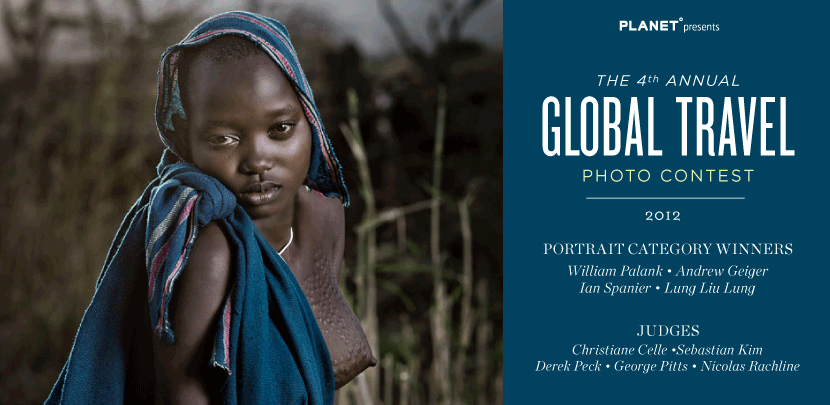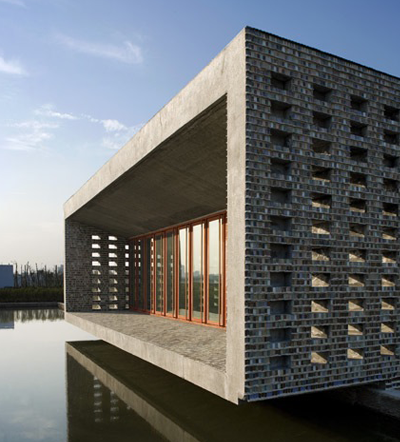
Ceramic House, 2003-2006, Jinhua, China. Photo by Lv Hengzhong.

When Hangzhou-based architect Wang Shu won the 2012 Pritzker Prize earlier this month, it marked a turning of the tide. Although the Pritzker, the discipline’s highest honor, has been awarded before to South American, Australian and Japanese architects, this is the first time it’s gone to a Chinese architect, and it seems just right. For too long people have understood high architecture as something that American and European designers practice and export to other parts of the world. Right now there’s a massive construction boom in China but it’s still projects designed by foreign offices, like OMA’s CCTV Tower and Herzog & de Meuron’s 2008 Olympic Stadium, both in Beijing, that grab the international spotlight. Although Shu has won major commissions throughout China and taught and lectured in the United States, he remains relatively unknown.
Shu’s buildings, designed with partner Lu Wenyu at Amateur Architecture Studio, have a distinctively earthy character. They’re massive volumes rendered with sensuous, tactile masonry surfaces. When he was young the architect worked for almost ten years on construction crews to master common building methods, and now he works closely with craftsmen to develop designs. He builds with everyday materials like poured concrete, fieldstone, and terra cotta tiles, which possess a reassuring heaviness. One of his signature strategies is to incorporate bricks and other materials salvaged from local demolition sites.
Slideshow
(more…)

All images by Richard Renadli

Richard Renaldi has had quite a career. His first book
Figure and Ground was published by the Aperture Foundation and since then he has been included in shows at the ICP and the Yossi Milo gallery. Naturally an extrovert and fascinated by people– “I’m the youngest of five from an Italian-American family,” he tells PLANET– Renaldi has documented a vast and colorful array of subjects from sexual minorities to civilians from small suburban towns such as Fall River, Massachusetts.
Renaldi’s work is consistently from a poignant and respectful perspective and is often humanistically humorous.
Bus Travelers likewise embodies these trademark characteristics that is prominent in Renaldi’s work. These attributes are not only results of Renaldi’s character but also due to his choice of medium. Working with a large-format 8 x 10 camera, also Richard Avedon’s choice of medium for creating In
The American West, the slow and meticulous process of photographing the subjects require the cooperation and patience of both the photographer and subject.
Slideshow
(more…)

Loretta Lux Portrait of Antonia, 2007 © Loretta Lux, Courtesy of the Artist and Yossi Milo Gallery, New York

Despite a cold and rainy night, the Yossi Milo Gallery was barely navigable at the opening for
First Look, the inaugural show in the gallery’s new space. A group exhibition of photographers whose first solo shows in New York were presented at Yossi Milo,
First Look brings together disparate images in a way that highlights their similarities and elucidates their shared truths.
Welcoming visitors to the gallery are two photographs by Pieter Hugo; in one a slum-dwelling Ghanaian girl clad in all white looks out from atop a gigantic mound of smoldering electronic waste, a bowl balanced on her head for the collection of valuable debris. Hanging opposite are three portraits of pink-lipped, primly dressed children taken by Loretta Lux. They are so wan their blue blood is almost visible beneath their skin, while their empty eyes render the images eerie, rather than the portraits of young idyll they may seem at first. This juxtaposition of Hugo’s and Lux’s images tempts the viewer to imagine that the girl on the garbage mound and the children in the portraits could look outside their frames to see each other across the room, and find some solace in their very different, yet equally terrifying worlds.
Slideshow
(more…)
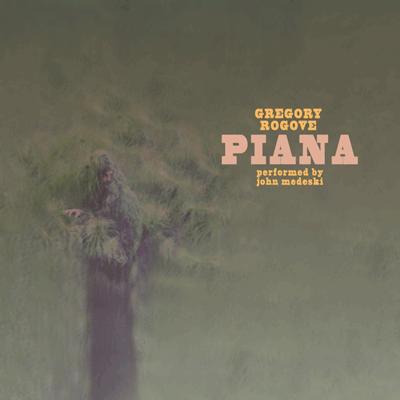

Instrumental albums tend to fall into one of two categories. The first is the hourlong symphony, in which a composer, usually a person used to working with a much smaller band, records a suite of songs with the aid of a roomful of musicians. The second is the medley of solo pieces, which depends on the composer’s ability to work well with economy and spareness. The first solo album by Gregory Rogove, Piana, sits firmly in the latter category. A collection of piano pieces written by Rogove and played ably by John Medeski (of Medeski, Martin and Wood), Piana fuses together a number of disparate song structures, each of which adds to a dominant mood of regret laced with hope for redemption. Veering deftly from tempo to tempo, from dirge to bolero to elegy, the album tracks the thoughts of a melancholic man who wants to know how to bury his mistakes. Upbeat tracks like “Jackyl” lend a manic edge to his musings, while eight-minute closer “Young Mountain” suggests his eventual resignation. All in all, it speaks to Rogove’s talents as a songwriter that Piana, despite its variety, communicates a singular loss.
(more…)
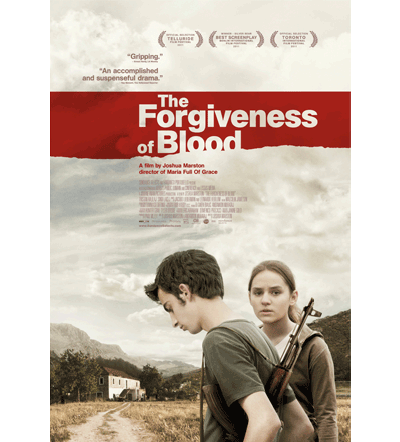


For his first film Maria Full of Grace, Joshua Marston teased an uncompromising and sincerely delicate story out of the world of Colombian drug trafficking, and won himself a slew of international awards in the process. Eight years later, his follow-up deals in a subject no less morally ambiguous. The Forgiveness of Blood asks what happens when two Albanian teenagers are drawn into a blood feud by their father, who may or may not have killed a man. Now according to Albanian social code, the family owes a life, and teenage siblings Nik and Rudina must put their entire lives on hold. The most jarring thing about these events is not the lengths the children must go to, or even the fact that all this is enforced by nothing but social code, with no state law to back it up. The real shock is that Nik and Rudina are modern-day Albanians bowing to a custom that’s hundreds, if not thousands, of years old.
Shot on location from an entirely Albanian script, Marston recruited a cast of non-professional actors and stayed close to the land to raise some essential questions. To what extent are we responsible for the actions and beliefs of our families? What is the “right” retribution for murder? And how long will this ancient practice survive?
CE: Why Albanian blood feuds?
JM: I think the thing that’s fascinating about the blood feuds was more the contrast of the old and the new in Albania. Specifically the idea that someone, a kid, could be sitting in his house playing video games and sending text messages, but the reason that he’s in his house is that he’s stuck in a feud because of this old, ancient tradition.
(more…)


Hugo Manuel’s vocals have never shown this level of precedence in Point of Go as in previous works, spanning from the lo-fi One Hundred Suns to the folk ambience of Sunny Casinos. Ever since joining Oxford’s Blessing Force collective, the members of Jonquil have not only reinvented their lineup and recording process, but they also seem to extend an unrevealed limb for pop in the gestalt of their songwriting. The electronic haze of “Getaway” is curtained precisely over simple, yet moody piano chords and mobilized percussion. Jonquil’s newest single, “It’s My Part,” boasts a stunningly gratifying catchiness from the first licks of electric guitar. The song’s lyrics may very well paint a picture of stage fright, which evolves into a self-realization arising as if spontaneously. Point of Go is a collection of jams more than suitable for driving towards a neon sunset, and should leave fans old and new eagerly speculating where Jonquil will end up next.

Audio clip: Adobe Flash Player (version 9 or above) is required to play this audio clip. Download the latest version here. You also need to have JavaScript enabled in your browser.
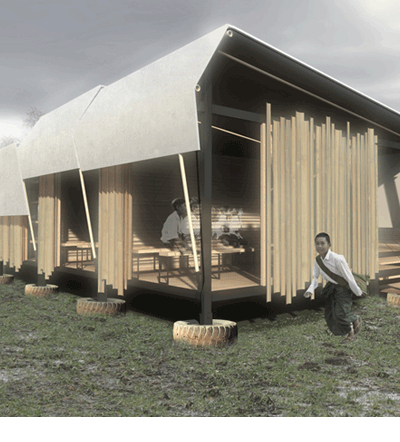
Winning design for Mae-Sot School. By Amadeo Bennetta / Daniel LaRossa, Berkeley, CA.

London-based architect David Cole was vacationing in Mae-Sot, Thailand, a town along the Burmese border, when he first learned about the plight of refugees there. Over the past twenty-five years some 30,000 Burmese have come to Mae-Sot to escape their country’s political violence. They live in camps with interim housing but without community buildings and schools. Cole warmed to the refugees he met, and saw the work that the
Burmese Migrant Workers Education Committee, the
Colabora Birmaina, and other organizations were doing on the ground.
After returning home, in order to build a school in Mae-Sot, Cole and industrial designer Louise McKillop founded
Building Trust International (BTI). The charity’s mission is to facilitate international building projects by assembling a specialized team of architects, engineers, sponsors, and other organizations. To solicit ideas for the Mae-Sot school, BTI organized an open design competition. The project brief called for a mobile structure that could serve as a school and community center. While the notion is simple the design problem isn’t. Since the refugees don’t have protected land rights, the structure has to be simple to assemble, transport and reassemble. And the structure needs to address the tropical climate, leverage local construction materials and techniques, and shape a deeply sheltering, inspiring space for the refugees. The competition attracted the interest of over 800 teams and some of the best entries were displayed at a pop-up gallery in London, generating even more interest.
Slideshow
(more…)

Tara Oceans/Tara Expeditions

So often it’s the night sky that captures the attention of people contemplating undiscovered forms of life. Yet stargazers might not always appreciate that however unlikely it is for any of us to learn of alien creatures from far off galaxies in our lifetimes, there is a much better chance for us to find never before seen living things in the oceans here on the planet Earth. So-called intelligent life probably isn’t lurking anywhere in the deep blue sea, except maybe in a ghost story or two, but it’s an accepted estimate within science that microbial diversity in the world’s oceans accounts for what are thought to be millions of unknown species of phytoplankton, including protists, small metazoans, viruses, and bacteria. If anyone intends to study these unknown microbes, though, they better do so before the organisms vanish along with eroding coral reefs and become characters in a ghost story of their own.
Warmer and acidified waters linked to human activities are disrupting subsurface ecosystems and turning the mission to study oceanic microorganisms into a race against time. A 2010 report in the journal Nature found that planktonic populations have declined by 40 percent since 1950. Appraising their health and numbers has significance beyond mere curiosity. As a food source, pelagic plankton constitute the foundation of the maritime food web. And as emitters of oxygen and as carbon sinks, they play a vital role in regulating the content and temperature of our atmosphere.
(more…)





 Facebook
Facebook Permalink
Permalink Digg
Digg Reddit
Reddit LinkedIn
LinkedIn StumbleUpon
StumbleUpon Tumblr
Tumblr


